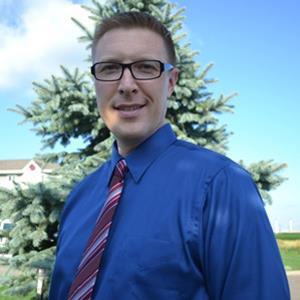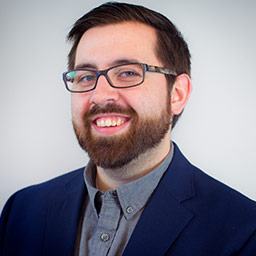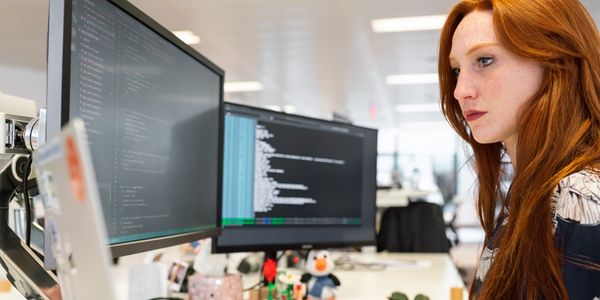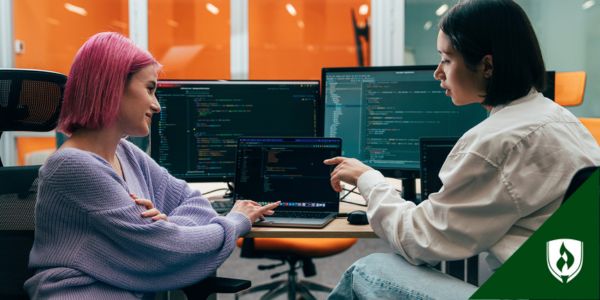In his previous career, Bloomington computer science graduate Michael Gunderson would be elbow-deep in auto parts, trying to piece together the remnants of a vehicle; now he is rolling his sleeves up and piecing together something entirely different—software. These jobs may seem vastly different but both boil down to piecing together parts of a system in order to make it more reliable and efficient.

This is how Gunderson has moved from nuts and bolts to scripts and syntax.
A long held curiosity
Growing up as the son of a software developer certainly helped give Gunderson an early familiarity with computers. He was once the proud owner of a Commodore 64—the crude early predecessor to modern video game consoles. While the technical specs of the system seem quaint in 2014, they were more than enough to hold Gunderson’s interest in computing for a lifetime. He spent hours as a kid playing games on the system. The process back then was much more than inserting a disk and turning on the power; he had to learn the basics of the language BASIC to even start playing.
Gunderson temporarily set aside his early experience with computers and focused his energy on earning an automotive tech degree after high school. The move toward becoming a mechanic was only natural. Gunderson says he’s always had a curiosity about how things work and would regularly take apart and tinker with his possessions—so why not get paid to do it?
Life as an auto mechanic allowed for plenty of tinkering, but Gunderson’s interests slowly shifted toward electronics. He earned another associate degree in electronics technology in 1999 and, after that, spent several years repairing and maintaining a variety of computers and electronics. He found himself picking up on pieces of programming during this time and decided that the next logical step would be to return to school to learn more. Gunderson says his time working with computers made the change to software development a smooth step.
“There was always some sort of programming involved with the job I did—whether it would be a microprocessor, a webpage or a user application—so I started getting into it,” Gunderson says. “Programming and computer science were always … in the back of my mind.”
Hardware to software
Gunderson eventually decided that he’d make the switch from the concrete world of motherboards and RAM to the more intangible field of computer science. He began another associate degree program in 2009 while also troubleshooting software for TE Connectivity. All went well except for one snag—his school at the time didn’t offer a bachelor’s degree program. A friend recommended the bachelor’s degree program at Rasmussen College just as Gunderson was weighing his academic options.
"I think there are a lot of people who could learn to program that don't think they can because they've seen too many movies where coding is just some guy typing gibberish."
Rasmussen College’s close campus location in Bloomington, Minnesota was ideal and the ability to flexibly schedule his classes was a huge benefit for a full-time worker and family man. He enrolled and began the bachelor’s degree program in 2011.
The litany of languages used in programming can be enough to make your head spin when just starting out, but Gunderson has taken on the task admirably. He says the best advice he can give for someone new to the field is to focus on one language and master it before branching out too far toward other languages.
“I think there are a lot of people who could learn to program that don’t think they can because they’ve seen too many movies where coding is just some guy typing gibberish,” Gunderson says. “Really, it’s a lot like learning a second language—once you know the basic syntax you start to figure out how to piece it together.”
Gunderson says he approached his schoolwork as if it was a job, and his professional attitude really helped him stay organized and on track. He set a rigid schedule for completing weekly reading assignments and discussion posts, and he says his wife did a great job of reminding him to keep up with his schedule and stay accountable. Their efforts have certainly paid off; Gunderson graduated with a bachelor’s degree in computer science in December 2013.
Bright future in new career
With a bachelor’s degree in hand, Gunderson started a new job working as a software developer for Pearson VUE where he works on web applications for scheduling tests and other exams. He says the complex nature of the work is both the most difficult part of the job and the most satisfying.
“Understanding how these systems work together can be challenging [and] a little frustrating,” Gunderson says. “But that’s also part of the fun if you’re like me and like taking stuff apart—it’s really enjoyable when you understand how something works and can then modify or improve it.”
Gunderson offered this advice for students looking to launch a software development career of their own—don’t wait until you have a job to start creating something. He says a big part of what helped him land his current job were the projects he took on outside of school. Extracurricular projects like creating his own Android apps helped him hone his technical skills and satisfy his passion for programming. He says the best way for a programmer to stand out is to dive right in and learn as much as possible along the way.
“Just get out there and program as much as you can so you can show employers what you’re capable of,” Gunderson says.
Get started
Are you ready to roll up your sleeves and dive deep into the nuts and bolts of programming? A bachelor’s degree in computer science can equip you with the skills needed to be a programming machine!




